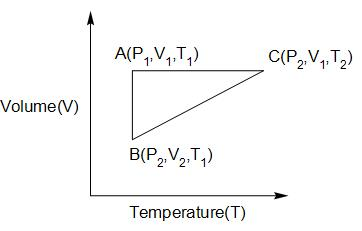Question
Question: A reversible cyclic process for an ideal gas is shown. Here \(P,V,T\) are pressure, volume and tempe...
A reversible cyclic process for an ideal gas is shown. Here P,V,T are pressure, volume and temperature, respectively. The thermodynamic parameters q,w,H,U are heat, work, enthalpy and internal energy, respectively. The correct option(s) is?

A. qAC=ΔUBC and wAB=P2(V2−V1)
B.qBC=ΔHAC and wBC=P2(V2−V1)
C. qAC=ΔUBC and ΔHCA<ΔUCA
D. qBC=ΔHAC and ΔHCA>ΔUCA
Solution
To answer this question, you need to recall the applications of first law of thermodynamics. The process AC is isochoric, process AB is isothermal and process BC is isobaric.
Formula used:
First law of thermodynamics: ΔU=q−w
Where, ΔU is the internal energy of the system, q is the heat change involved in the process, w is the work done
Complete step by step answer:
Since the process is cyclic, we can say that ΔHAC+ΔHCB+ΔHBA=0.
We know that, in an isochoric process, the change in volume during the process is zero hence work done will be zero across the process AC.
In an isothermal process, the temperature remains constant throughout and thus, the change in internal energy is zero. Also, the enthalpy change for an isothermal process is zero.
Thus, we can say that ΔHAC=ΔHBC
For an isobaric process, we have that qp=ΔH
⇒qbc=ΔHBC=ΔHAC
The work done in an isothermal process is given by, WAB=nRTln(V1V2)
Therefore, option A is incorrect.
Since qbc=ΔHAC and work done at constant pressure is P(V2−V1), option B is correct.
We know that, ΔH⩽ΔU.
Thus, we can say that ΔHCA<ΔUCA.
Therefore, option C is correct and option D is incorrect.
Hence, the correct options are B and C.
Note:
The first law of thermodynamics is a version of the law of conservation of energy, modified for thermodynamic processes, distinguishing two types of transfer of energy, as heat transferred and thermodynamic work done, and relating them toInternal energy which is a function of a body's state. The law of conservation of energy states that the energy of any isolated system is always constant. In layman terms, energy can be transformed from one form to another, but can neither be created nor be destroyed.
